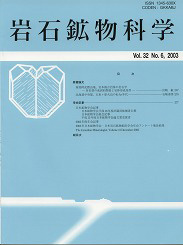巻号一覧

37 巻 (2008)
- 6 号 p. 153-
- 5 号 p. 131-
- 4 号 p. 91-
- 3 号 p. 69-
- 2 号 p. 27-
- 1 号 p. 1-
前身誌
37 巻, 5 号
September
選択された号の論文の2件中1~2を表示しています
- |<
- <
- 1
- >
- >|
原著論文
-
梅田 浩司, 檀原 徹2008 年 37 巻 5 号 p. 131-136
発行日: 2008年
公開日: 2008/12/19
ジャーナル フリーDuring the latest phase of eruptive activity by the Mutsu-Hiuchidake volcano, Northeast Japan, large pyroclastic flows were estimated by previous geological and tephrochronological studies to have occurred at about 0.3 Ma. In this re-examination of the latest volcanic history, we present new fission-track ages for two zircons from the pyroclastic flow deposits from the volcano and two from the associated basement rocks. FT ages determined for the pyroclastic flow deposits are 0.81 ± 0.14 Ma and 0.77 ± 0.10 Ma compared to the 2.6 ± 0.2 Ma and 3.0 ± 0.3 Ma ages for the basement rocks. These results confirm that the lavas at the top of the volcanic edifice are younger than the pyroclastic flow deposits. In addition, the volcano is estimated to have been active from 1.2 to 0.5 Ma, based on other K-Ar ages, TL ages and stratigraphic relationships.抄録全体を表示PDF形式でダウンロード (1474K) -
影山 達也2008 年 37 巻 5 号 p. 137-145
発行日: 2008年
公開日: 2008/12/19
ジャーナル フリーHydrothermal synthesis of ferrobustamite has been carried out at temperatures between 350 and 850 °C, and 100 MPa pressure using CaCO3, FeCl2·4H2O and SiO2 as starting materials. Above 500 °C, formation of ferrobustamite was confirmed by XRD. The FeSiO3 contents in ferrobustamite ranging from 14.7 to 22.9 mol%, and the solid solution range extends towards high FeSiO3 contents with increasing temperature.
X-ray microprobe analyses of ferrobustamite showed as tiny grains associated with xonotlite, when it was synthesized hydrothermally at 350 °C from starting material-mixtures of Ca(OH)2, CaCl2·2H2O, FeCl2·4H2O and SiO2. Ferrobustamite was also formed by reheating at 350 °C of the metastable phase with Ca0.9Fe0.1SiO3 held prepared beforehand from a composition between those of ferrobustamite and wollastonite, and quenched from 750 °C. These experimental results suggest that ferrobustamite is stable and there is an immiscibility gap between ferrobustamite and wollastonite at low temperatures around 350 °C, such as the temperature of skarn-formation.抄録全体を表示PDF形式でダウンロード (2145K)
- |<
- <
- 1
- >
- >|